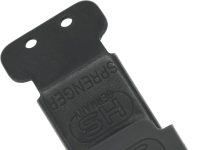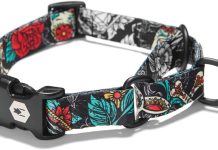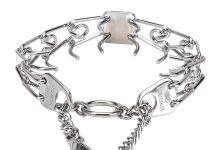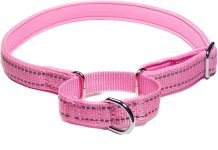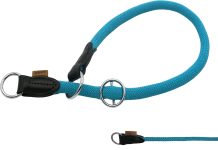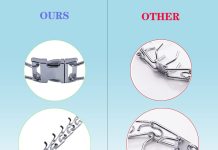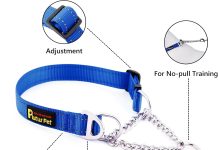In this article, we explore a common concern among pet owners: the risk of neck injury when using a collar on their furry friends. We’ll examine whether a harness can provide a safer alternative and reduce the likelihood of harm to our beloved companions. Join us as we delve into the potential benefits and considerations of using a harness as opposed to a collar for your pet.
Understanding the Neck Injury Risk
Neck injuries in dogs are a common concern among pet owners, as they can lead to pain, discomfort, and potential long-term health issues. To understand how a harness can help reduce the risk of neck injury, it is essential to first grasp the anatomy of the neck and the common types of neck injuries that can occur in dogs.
Table of Contents
The Anatomy of the Neck
The neck of a dog is a delicate and complex structure consisting of bones, muscles, tendons, ligaments, and the trachea (windpipe). The cervical spine, also known as the neck vertebrae, provides support and flexibility, allowing dogs to move their heads freely. The trachea, located in front of the neck, is responsible for air passage during breathing.
Common Neck Injuries in Dogs
Dogs are susceptible to various neck injuries, which can range from mild strains to severe trauma. Some of the most common neck injuries in dogs include:
-
Whiplash: Sudden jerking movements of the head and neck can cause whiplash, resulting in soft tissue damage and muscle strain.
-
Intervertebral Disc Disease (IVDD): This condition occurs when the discs between the vertebrae in the neck become degenerated or herniated, causing compression on the spinal cord.
-
Strangulation: Dogs who pull excessively on traditional collars can put strain on their necks, leading to potential tracheal damage or even strangulation if the collar gets caught on an object.
The Role of Harnesses
Harnesses serve as a viable alternative to traditional collars and play a crucial role in ensuring the safety and well-being of dogs. Harnesses are designed to distribute force evenly across a dog’s body, minimizing strain on the neck and reducing the risk of neck injuries.
Function and Design
Harnesses are typically made of adjustable straps that wrap around a dog’s chest, shoulders, and back. They feature various attachment points for leashes, providing different levels of control and support. The function of a harness is to redirect the force exerted by a dog during leash pulling away from the neck towards the body.
Differences Between Harnesses and Collars
Collars are the traditional method of restraint for dogs, but they can pose risks, especially for dogs prone to neck injuries. Collars put pressure directly on the neck, potentially causing strain on the cervical spine and the delicate structures within the neck. In contrast, harnesses distribute pressure across a larger area, reducing the impact on the neck.
Benefits of Using a Harness
Using a harness instead of a collar offers several benefits for both dogs and their owners. Let’s explore some of the advantages that make harnesses a safer and more comfortable option for dogs.
Even Distribution of Force
Harnesses are specifically designed to distribute the force of leash pulling evenly across a dog’s body. By spreading the pressure over a larger surface area, harnesses minimize the risk of strain on the neck and redirect the force towards the chest and shoulders, which are better equipped to handle the load.
Minimizing Strain on the Neck
Due to their unique design, harnesses alleviate the strain on a dog’s neck, which is particularly beneficial for dogs with pre-existing neck injuries or conditions such as IVDD. By reducing the pressure on the neck, harnesses help prevent exacerbation of existing injuries and promote better overall neck health.
Preventing Tracheal Damage
One of the most significant risks associated with collar usage is the potential for tracheal damage. Dogs that pull on collars excessively may experience tracheal collapse or irritation, leading to breathing difficulties. Harnesses eliminate this risk by redirecting the pressure away from the delicate trachea, safeguarding the dog’s respiratory system and promoting unrestricted breathing.
Harness Types and Their Impact
Harnesses come in various styles and designs, each serving different purposes and providing unique advantages. Let’s take a closer look at some of the most commonly used harness types and their impact on reducing the risk of neck injuries.
Front-Attach Harness
Front-attach harnesses feature a leash attachment point located on the chest area, near the dog’s sternum. This style of harness helps discourage pulling by redirecting the dog’s forward momentum to the side, encouraging them to face the handler. By discouraging excessive leash pulling, front-attach harnesses can reduce strain on the neck and minimize the risk of neck injuries.
Back-Attach Harness
Back-attach harnesses have a leash attachment point located on the back, between the dog’s shoulder blades. This type of harness provides more control and stability, as the force from leash pulling is distributed across the shoulders and upper body. Back-attach harnesses are especially beneficial for dogs who have neck injuries or require additional support.
Head Halter Harness
Head halter harnesses resemble muzzles but work differently. They wrap around a dog’s snout and neck and provide control by gently guiding the head and limiting forward motion. This type of harness reduces the strain on the neck and provides control over the dog’s movements, making it an effective option for dogs who are strong pullers or have a tendency to lunge.
Considerations for Choosing a Harness
When selecting a harness for your dog, several factors should be taken into consideration to ensure the best fit, functionality, and safety. Let’s explore these considerations more closely.
Proper Fit and Adjustment
A harness should fit snugly but not restrictively around the dog’s body. It is essential to choose the correct size harness for your dog’s breed and size, ensuring that there is no excessive pressure on the chest, neck, or shoulders. Adjustable straps and buckles allow for a customized fit, allowing the harness to grow with your dog and accommodate any changes in weight or body shape.
Comfort and Ease of Use
A comfortable harness is essential for long-term usage. Look for harnesses made of soft yet durable materials that won’t rub or chafe your dog’s skin. Padded or cushioned areas on the chest and shoulder straps can provide additional comfort. Additionally, consider ease of use, such as quick-release buckles and adjustable straps that allow for effortless application and removal.
Training and Behavior Modification
Harnesses can be valuable tools for training and behavior modification. Some harnesses are specifically designed to assist in discouraging pulling or promoting proper walking etiquette. Consider your dog’s specific training needs and behavioral challenges when selecting a harness, and consult with a professional trainer if necessary.
Potential Drawbacks of Harnesses
While harnesses offer numerous benefits, it is essential to consider potential drawbacks that may arise from their use.
Restricting Natural Movement
Certain types of harnesses, such as head halter harnesses, may restrict a dog’s natural movement to some degree. This can be particularly noticeable when a dog tries to sniff, eat, or interact with their environment. While these restrictions are usually minimal and temporary, they are worth considering in relation to your dog’s daily activities and comfort.
Additional Weight and Bulkiness
Harnesses are generally more substantial than collars due to the presence of straps and buckles. The added weight and bulkiness may take some getting used to, especially for smaller or more sensitive dogs. It is essential to gradually introduce your dog to wearing a harness and monitor their comfort level during initial use.
Addressing Common Concerns
Some common concerns related to harness usage include their effectiveness for small versus large breeds and their impact on breathing and panting. Let’s address these concerns to provide a more comprehensive understanding of harnesses.
Effectiveness for Small vs. Large Breeds
Harnesses can be equally effective for both small and large breeds. The key is selecting the appropriate size and style of harness that suits your dog’s specific needs. Smaller breeds may benefit from lightweight and minimalistic harness designs, while larger breeds may require sturdier harnesses with broader straps and reinforced attachment points. Consult with your veterinarian or a professional trainer to determine the best harness for your dog’s size and breed.
Impact on Breathing and Panting
Properly fitted harnesses should not interfere with a dog’s breathing or panting ability. When choosing a harness, ensure that it provides ample room for the dog’s neck and chest to expand comfortably during breathing. Additionally, opt for harnesses made of breathable materials that allow air circulation. Regular monitoring of your dog during and after exercise is also crucial to ensure that they can breathe and pant without any issues.
Studies and Research Findings
Numerous studies have been conducted to evaluate the comparative effectiveness of collars and harnesses in reducing neck injuries and promoting overall canine welfare. Let’s explore some key findings from these studies.
Comparative Analysis of Collars and Harnesses
A study published in the Journal of the American Veterinary Medical Association compared the effects of collars and harnesses on neck pressure in dogs. The study found that collars exerted significantly higher pressure on a dog’s neck compared to harnesses. This highlights the potential for harnesses to reduce the risk of neck injuries by distributing force more evenly across the body.
Long-term Observation Studies
Long-term observation studies have shown that dogs who wear harnesses experience a reduction in neck injuries, such as tracheal damage and cervical spine issues. Furthermore, these studies have reported improvements in behavior, gait, and overall well-being among dogs using harnesses. These findings support the notion that harnesses can play a significant role in preventing and managing neck injuries in dogs.
Injury Prevention Effectiveness
Harnesses have been found to be effective in preventing and reducing the severity of injuries caused by leash pulling. By evenly distributing force, harnesses help prevent strains, sprains, and other soft tissue injuries that can result from sudden jerking movements. This makes them a valuable tool for injury prevention, particularly for dogs who tend to pull on the leash during walks.
Tips for Proper Harness Usage
To ensure the optimal safety and effectiveness of a harness, consider the following tips for proper usage:
Introduction and Familiarization Period
Introduce the harness gradually to your dog, allowing them time to become familiar with wearing it. Start with short periods of wear and gradually increase the duration as your dog becomes more comfortable. Positive reinforcement, such as treats and praise, can help create a positive association with the harness.
Correct Positioning of Straps
Position the straps of the harness correctly to achieve the desired fit and function. Chest straps should sit snugly behind the front legs, avoiding any unnecessary pressure on sensitive areas. Neck straps should be positioned high enough to provide support but not restrict breathing or movement.
Regular Inspection and Maintenance
Regularly inspect the harness for signs of wear and tear, such as frayed straps or loose stitching. Replace the harness if any damage is detected to ensure continued safety. Additionally, clean the harness as instructed by the manufacturer to maintain hygiene and prevent odor buildup.
Conclusion
In conclusion, harnesses offer a safer and more comfortable alternative to traditional collars, particularly for dogs at risk of neck injuries. By distributing force evenly across a dog’s body and minimizing strain on the neck, harnesses can help prevent and manage neck injuries, promote better overall neck health, and enhance the overall well-being of our furry friends. When selecting a harness, consider factors such as proper fit, comfort, and functionality to ensure the best possible outcome. Harness up, and enjoy your walks with peace of mind knowing that you are prioritizing your dog’s safety and welfare.


